Published: June 01,2023

In Madagascar, an Indian Ocean island country, the month of May is in the autumn season. Hu Yuefang, a Chinese hybrid rice expert, rushes to harvest the last batch of hybrid rice with local farmers in a field at the China National Hybrid Rice Research and Development Center’s Africa sub-center in Mahitsy, a town 35 km northwest of the Madagascan capital of Antananarivo.
“There has been a lot of rain, and the temperatures have been very low over the last few days, so the harvest has to be done quickly,” said the 65-year-old Chinese expert.
Rice growing is the main agricultural activity in Madagascar. According to official statistics, more than half of all farmland is devoted to rice, and more than two-thirds of Malagasy households grow rice. However, due to a number of factors, such as seed quality, farming techniques and infrastructure, rice production in Madagascar is unable to fully meet the food needs of its population, forcing it to resort to imports.
The introduction of hybrid rice with a higher yield per cultivated area has given Madagascar hope of achieving food self-sufficiency. Since 2007, the country has been cooperating with China in the development of hybrid rice.
In 2008, Hu Yuefang left his hometown of Yiyang, in the southern Chinese province of Hunan, to travel to the African island as an expert in hybrid rice technology. Since then, he has been studying hybrid rice varieties adapted to local natural conditions and helping local people find the best way to increase their production.
Soon after his arrival, Hu realized that the natural environment here was very different from that in China, and that it was unrealistic to directly apply the experience of the research carried out in his own country.
The climatic conditions in Madagascar are complex and varied. With a surface area of around 600,000 square kilometers, the island offers a variety of climates, mixing tropical rainforest, savannah, tropical plateau and semi-arid zone. The different temperature and rainfall conditions at low, medium and high altitudes also pose serious problems for the study of the local adaptability of hybrid rice.
In order to find the best-adapted varieties, Hu and his team have traveled to almost every rice-growing area on the island. Their research required a year-round presence in isolated rural areas. They have lived in farmers’ huts, collected rainwater from tin roofs to drink, and walked to markets more than 10 km away to buy firewood for cooking.
In 2010, Hu and his team successfully selected three hybrid rice varieties capable of achieving high yields in local low-, medium- and high-altitude areas, receiving technical validation from Madagascar’s Ministry of Agriculture to be promoted and planted throughout the country.
“The yield per hectare of these three hybrid rice varieties is three to four times higher than that of traditional Malagasy rice,” noted Hu.
Compared with conventional rice, hybrid rice has a higher yield. However, growing hybrid rice also involves technical work. “Previously, local farmers were not used to intensive farming,” he noted.
Over the past decade, as well as training hundreds of local technicians and farmers, Hu has been available at all times to give countless pieces of technical advice. “Sometimes, farmers temporarily encounter tricky technical problems. If they live nearby, I go by motorbike. If they live far away and I can’t get there, I communicate remotely with them by phone to give advice,” he said.
Thanks to the joint efforts of Hu and other Chinese experts, the cumulative area of Chinese hybrid rice cultivation in Madagascar has exceeded 50,000 hectares, with an average yield of around 7.5 tonnes per hectare. In this respect, Madagascar has taken a major step toward food self-sufficiency.
However, the expert stressed that research into the local adaptability of hybrid rice did not stop there. Other Chinese experts will continue to carry out meticulous research in Madagascar to find hybrid rice varieties with greater adaptability and higher yields, using less fertilizer and offering better quality.
In May 2019, the China National Hybrid Rice Research and Development Center’s Africa sub-center was officially inaugurated in Madagascar. According to Zhang Lijun, the executive director of the Africa sub-center, the institution “hopes to draw on China’s hybrid rice technology to help the whole of Africa achieve the goal of eradicating hunger and ensuring food security as soon as possible.” ■
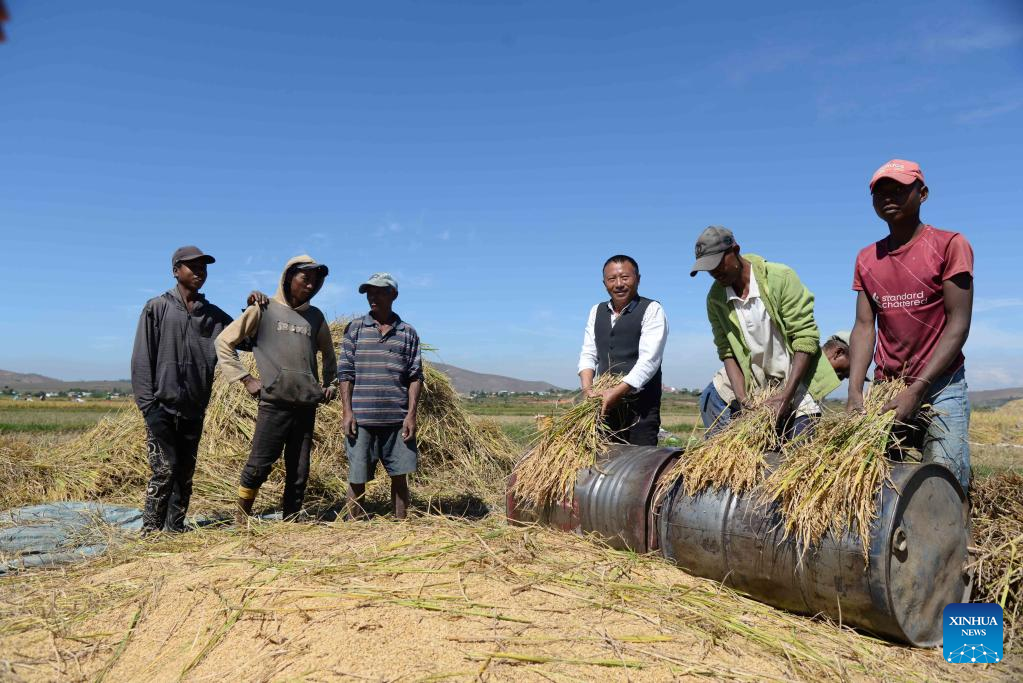
Hu Yuefang (4th L), a Chinese hybrid rice expert, works with local farmers in a field in Mahitsy, Madagascar, on May 12, 2023. In Madagascar, an Indian Ocean island country, the month of May is in the autumn season. Hu Yuefang, a Chinese hybrid rice expert, rushes to harvest the last batch of hybrid rice with local farmers in a field at the China National Hybrid Rice Research and Development Center’s Africa sub-center in Mahitsy. (Xinhua/Sitraka Rajaonarison)
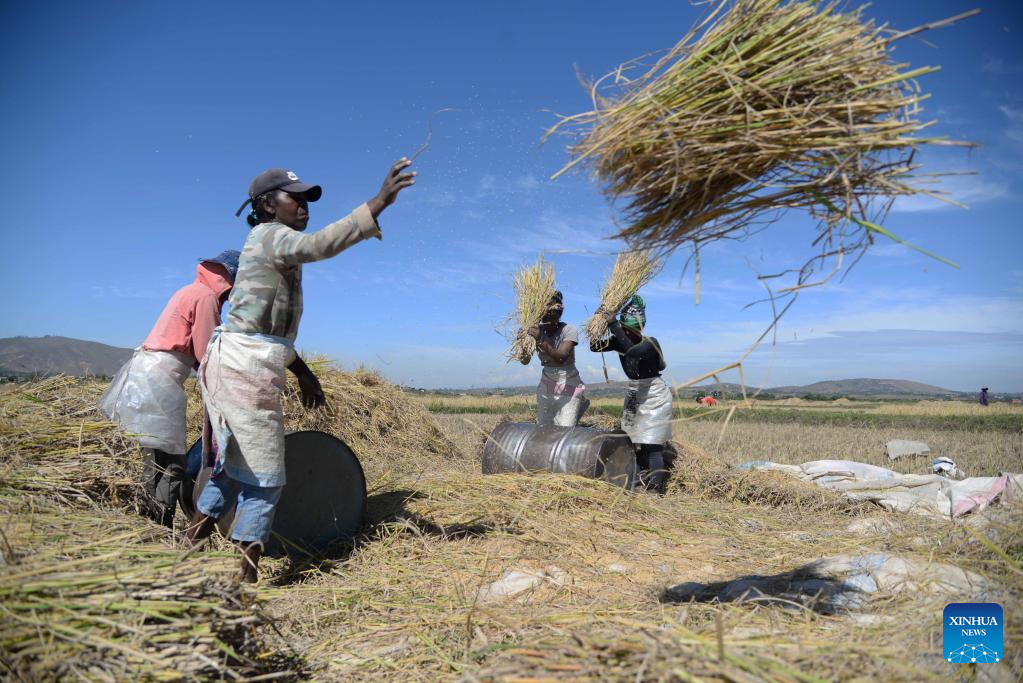
Local farmers harvest rice in a field at the China National Hybrid Rice Research and Development Center’s Africa sub-center in Mahitsy, Madagascar, on May 12, 2023. In Madagascar, an Indian Ocean island country, the month of May is in the autumn season. Hu Yuefang, a Chinese hybrid rice expert, rushes to harvest the last batch of hybrid rice with local farmers in a field at the China National Hybrid Rice Research and Development Center’s Africa sub-center in Mahitsy. (Xinhua/Sitraka Rajaonarison)
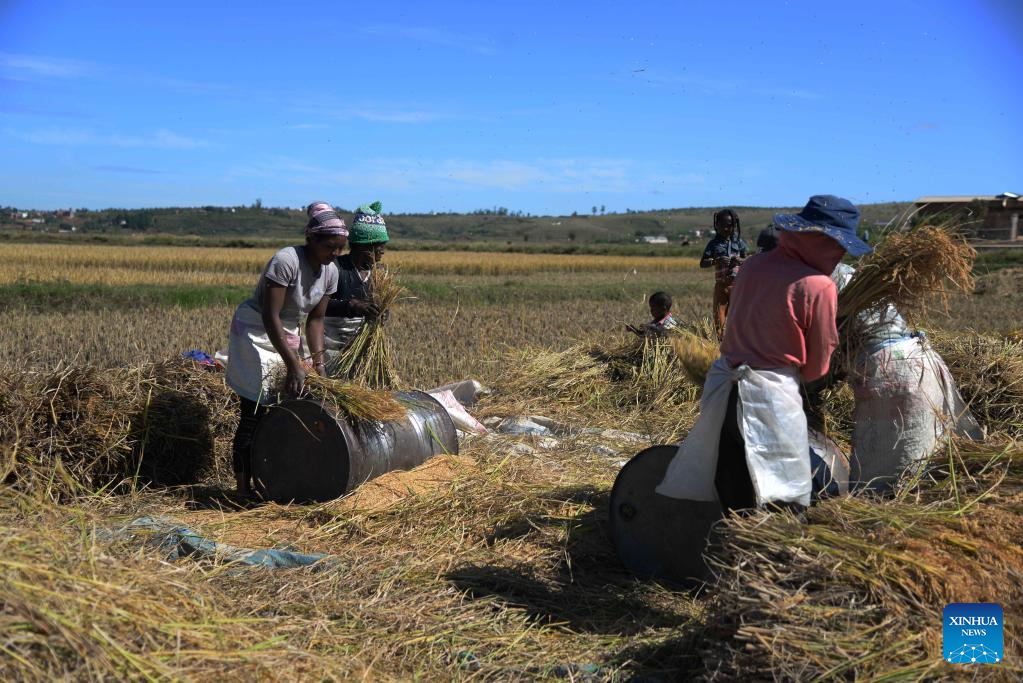
Local farmers harvest rice in a field at the China National Hybrid Rice Research and Development Center’s Africa sub-center in Mahitsy, Madagascar, on May 12, 2023. In Madagascar, an Indian Ocean island country, the month of May is in the autumn season. Hu Yuefang, a Chinese hybrid rice expert, rushes to harvest the last batch of hybrid rice with local farmers in a field at the China National Hybrid Rice Research and Development Center’s Africa sub-center in Mahitsy. (Xinhua/Sitraka Rajaonarison)
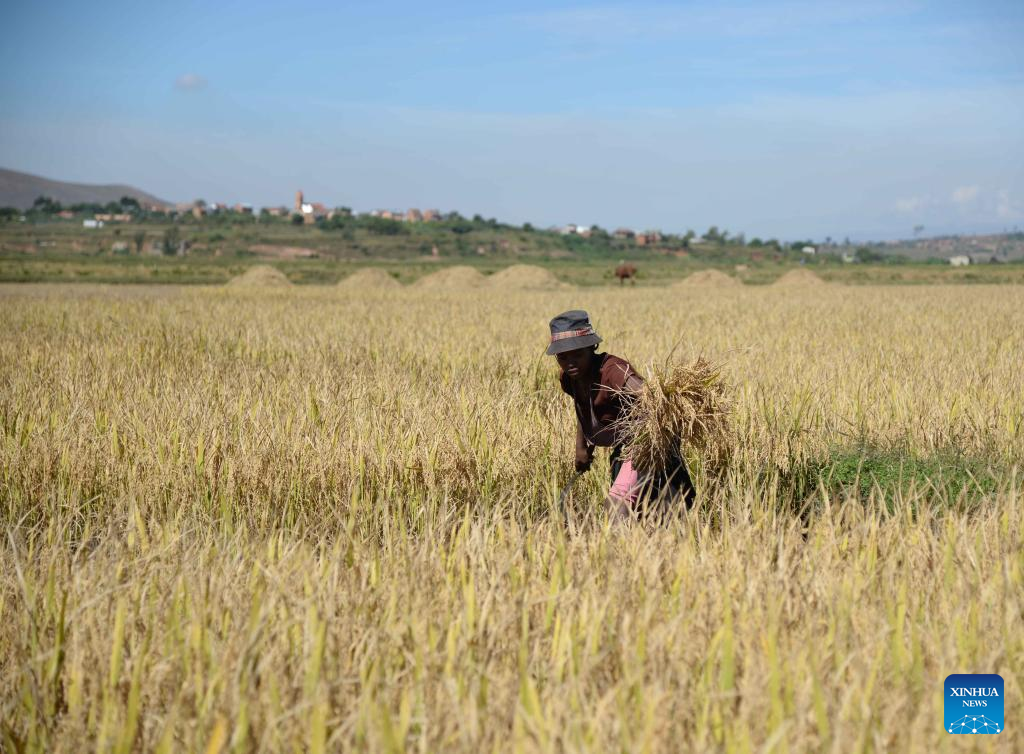
A local farmer harvests rice in a field at the China National Hybrid Rice Research and Development Center’s Africa sub-center in Mahitsy, Madagascar, on May 12, 2023. In Madagascar, an Indian Ocean island country, the month of May is in the autumn season. Hu Yuefang, a Chinese hybrid rice expert, rushes to harvest the last batch of hybrid rice with local farmers in a field at the China National Hybrid Rice Research and Development Center’s Africa sub-center in Mahitsy. (Xinhua/Sitraka Rajaonarison)
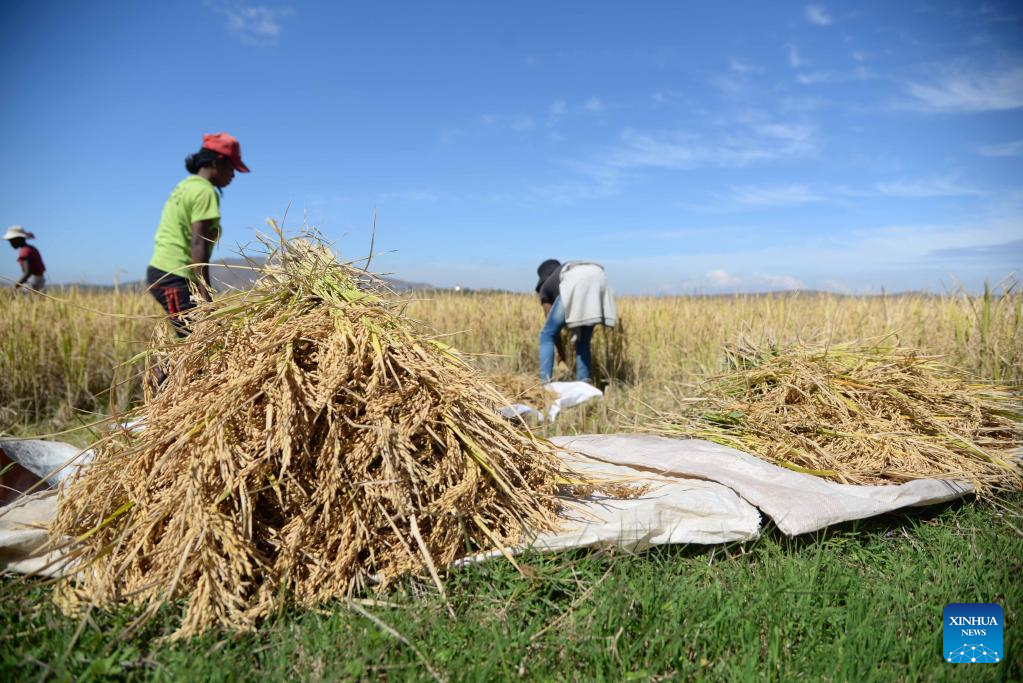
Local farmers harvest rice in a field at the China National Hybrid Rice Research and Development Center’s Africa sub-center in Mahitsy, Madagascar, on May 12, 2023. In Madagascar, an Indian Ocean island country, the month of May is in the autumn season. Hu Yuefang, a Chinese hybrid rice expert, rushes to harvest the last batch of hybrid rice with local farmers in a field at the China National Hybrid Rice Research and Development Center’s Africa sub-center in Mahitsy. (Xinhua/Sitraka Rajaonarison)
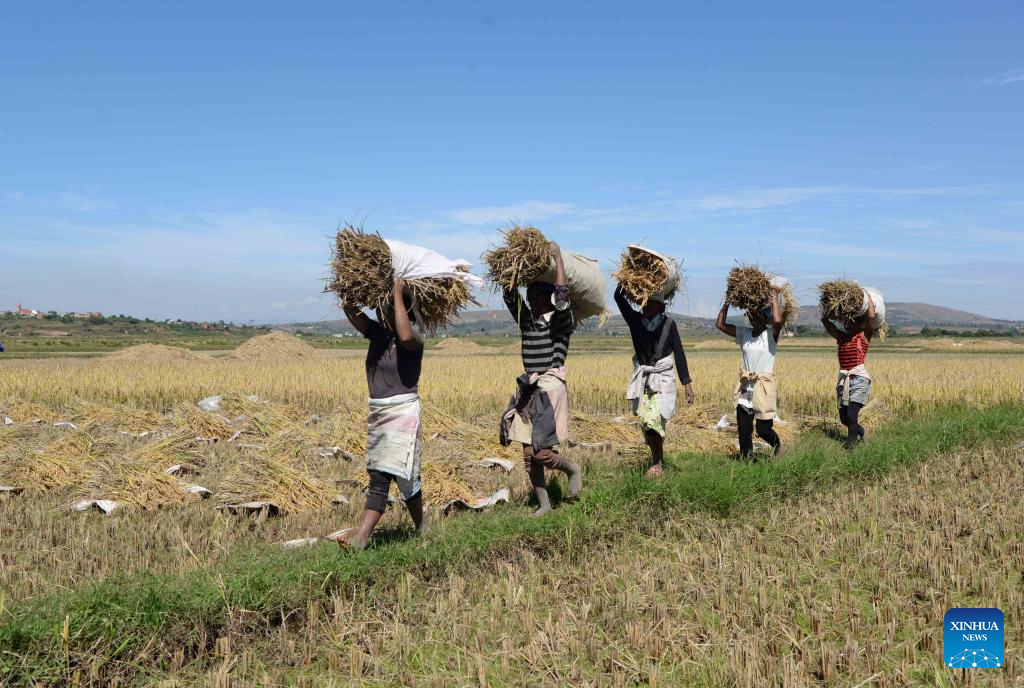
Local farmers harvest rice in a field in Mahitsy, a town 35 km northwest of Antananarivo, Madagascar, on May 12, 2023. In Madagascar, an Indian Ocean island country, the month of May is in the autumn season. Hu Yuefang, a Chinese hybrid rice expert, rushes to harvest the last batch of hybrid rice with local farmers in a field at the China National Hybrid Rice Research and Development Center’s Africa sub-center in Mahitsy. (Xinhua/Sitraka Rajaonarison)
Source:Xinhua
 Africa -China Review Africa -China Cooperation and Transformation
Africa -China Review Africa -China Cooperation and Transformation
